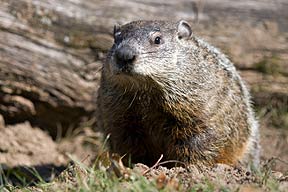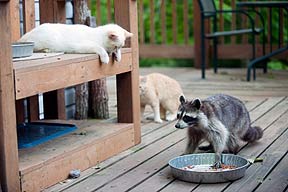 Animal Services Officers (ASOs) are primarily empowered to address concerns related to companion animals. However, ASOs may respond to calls within city limits regarding wildlife causing an immediate public safety hazard or injured wildlife when species-specific services are available and outweigh the stress of captivity. Living in harmony with wildlife in our community often poses some challenging situations to citizens. We have included useful information you may need from the professionals regarding humane alternatives to dealing with nuisance wildlife. Keeping garbage can lids secure, garage doors closed, and possibly suspending your bird feeding activities for a while may be necessary.
Animal Services Officers (ASOs) are primarily empowered to address concerns related to companion animals. However, ASOs may respond to calls within city limits regarding wildlife causing an immediate public safety hazard or injured wildlife when species-specific services are available and outweigh the stress of captivity. Living in harmony with wildlife in our community often poses some challenging situations to citizens. We have included useful information you may need from the professionals regarding humane alternatives to dealing with nuisance wildlife. Keeping garbage can lids secure, garage doors closed, and possibly suspending your bird feeding activities for a while may be necessary.
When wild animals have set up housekeeping in your attic, obtain a live trap from a supply rental company or garden center. When a healthy, wild animal is trapped, cover the trap with a towel or blanket, take it outside, and release the animal at the edge of your property. If there are concerns about re-entry that will require securing the residence and installation of exclusionary devices, contact a private nuisance wildlife control company that offers these types of services. Do not attempt to relocate a wild animal yourself as such transportation and release is regulated by the New York State Department of Environmental Conservation and requires a license. Wildlife that have actually entered and are currently accessible in the living space of your home can be removed by an Animal Services Officer. Live traps are not recommended for nuisance wildlife living outside, as exclusion tactics and deterrents are the best method of dealing with these animals rather than relocation. See Wild Neighbors for guidance.
 For injured wildlife, call 311 and an Animal Services Officer will respond and transport the animal to a veterinarian or licensed wildlife rehabilitator for treatment or humane euthanasia. Do not put yourself at risk of being bitten. If there is concern regarding a bite, call us to pick up the injured animal.
For injured wildlife, call 311 and an Animal Services Officer will respond and transport the animal to a veterinarian or licensed wildlife rehabilitator for treatment or humane euthanasia. Do not put yourself at risk of being bitten. If there is concern regarding a bite, call us to pick up the injured animal.
Living with Local Wildlife
A common misconception is that setting a live trap, catching the woodchuck, raccoon, skunk or opossum and destroying it or relocating it will take care of the nuisance. However, before too long another woodchuck, raccoon, skunk or opossum will move into the area. If it was a good habitat for one, it's just as good for another. Urban wildlife enjoy the easy life we often unknowingly provide for them; they don't like a hostile environment. Taking steps to deter them will encourage them to move on. The Humane Society of the United States (HSUS) is a wealth of information on living and dealing with our wild neighbors.
NACA Position Statement - Animal Control Intake of Healthy Wildlife
Find Answers and Humane Solutions to Problems With Wildlife